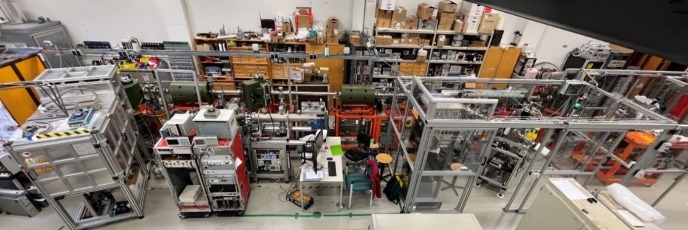Experimental Atomic Physics
Our experimental research efforts in the field of Atomic Physics address dynamical processes, induced by energetic interactions with atoms, molecules, clusters and solid surfaces. Secondary processes like molecular fragmentation, light or particle emission are observed and analyzed to understand the primary processes. Fundamental knowledge obtained in this way is applied to understand properties of plasma ranging from astrophysics (solar wind / space weather) via fusion (ITER) to EUV sources for nanolithography. Nowadays most of our efforts deal with Ion Interactions happening in and around Sn plasma used as the EUV light source for lithography, and are performed in a collaboration network with ARCNL and ASML.
Ion Interactions
Pushing EUV plasma sources for nanolithography to ever higher powers increases the load of plasma debris on the EUV optics facing the plasma. Plasma “debris” comprises of, e.g., tiny tin microdroplets, fast tin ions, or ions accelerated to the mirror surface by the plasma sheath. A large flow of H2 buffer gas is used to mitigate so-called “entrainable” debris. The Ion Interactions group investigates (1) the stopping power of H2 buffer gas for tin ions in selected charge states and kinetic energies and (2) the sputtering and implantation rate of tin ions on clean and debris-covered metallic surfaces relevant for EUV optics. The focus is on experiment as theory is insufficiently accurate. These studies are performed using our ZERNIKELEIF ion beam facility at the University of Groningen.

ZERNIKELEIF is a unique low-energy ion beam facility at which (multiply) charged tin ion beams can be produced that are selected on energy, charge state, and mass. The ECRIS (Electron Cyclotron Resonance Ion Source) type ion source can be operated at voltages up to 30 kV. The ion beams extracted from the ECRIS serve two set ups dedicated to ARCNL experiments. Both setups and their auxiliary equipment are sitting on a HV platform to allow for the deceleration of the Sn ion beams to virtually 0 eV to cover the full energy range relevant to Sn plasma EUV sources. The first one is a crossed-beam type setup in which the interaction of tin ions with gasses can be investigated. The second setup is designed to study interactions on surfaces.
| Last modified: | 08 December 2022 11.43 a.m. |
